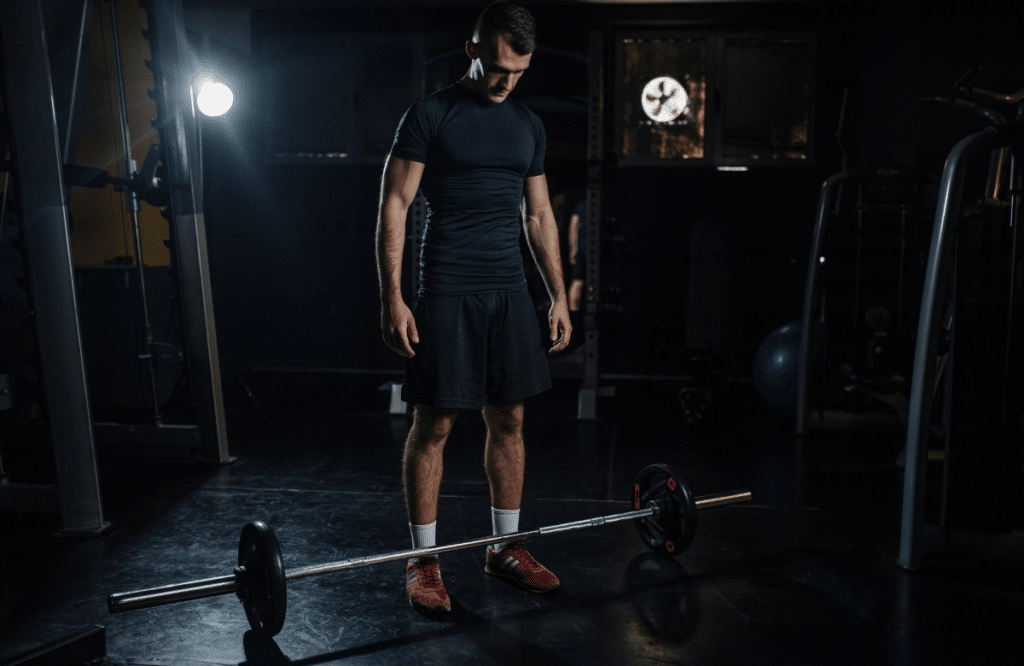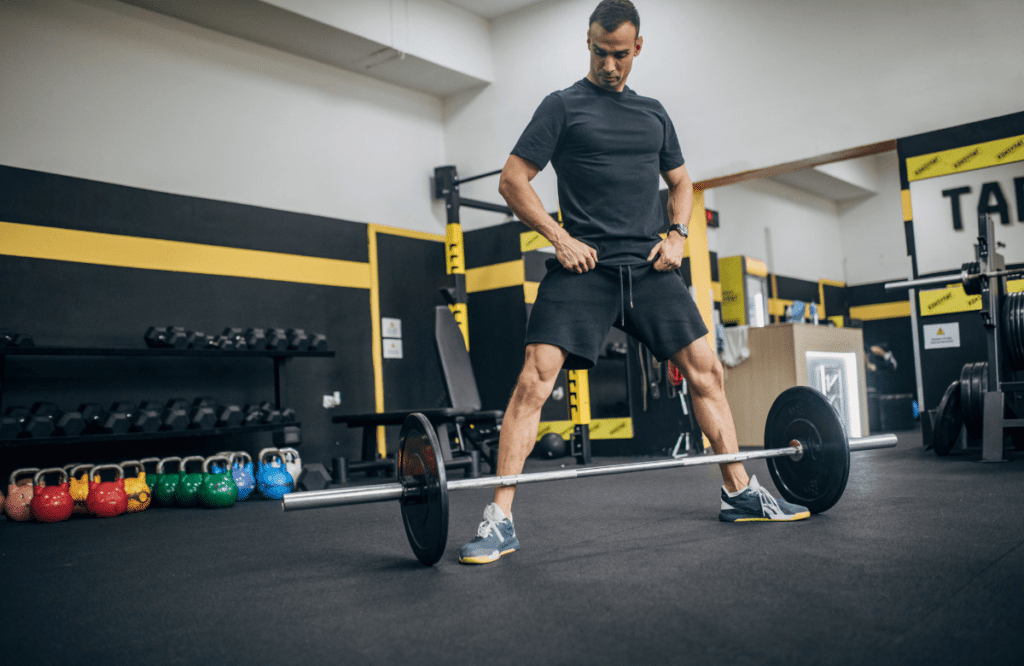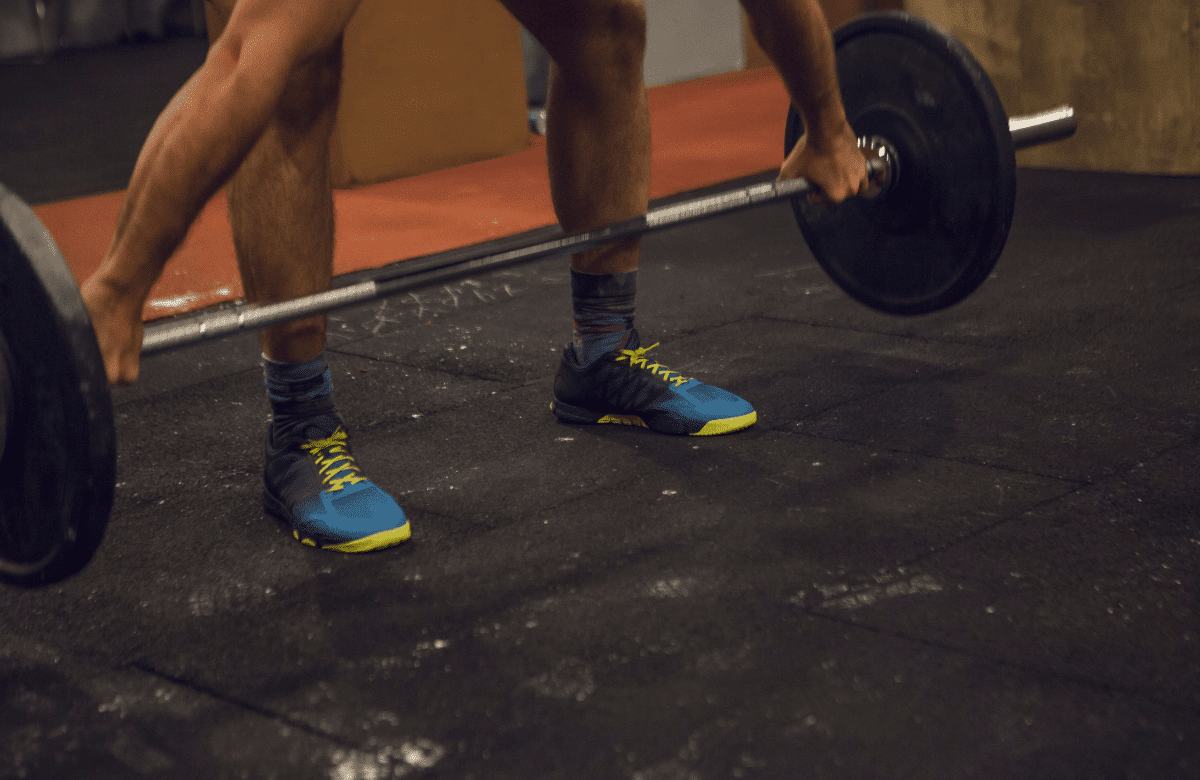The barbell deadlift is one of the cornerstones of strength. Pulling heavy weights off the ground is what lifting is all about, right?
So, what’s the best deadlift routine for beginners, and how can you get the most out of your time at the gym?
Here’s everything you need to know to start building brute strength and improve your conventional deadlift.
Jump to:
What Makes a Great Beginner Deadlift Routine?
Before you can find the best beginner deadlift routine, you have to determine what makes a great program in the first place. Beginner and novice lifters need to prioritize the following factors:
- Learning the correct technique
- Progressive overload
- Frequency of training
Learning and mastering the hip hinge technique ensures you complete your lifts safely and effectively. This way, you’re getting the most out of your deadlift sessions and learning skills that transfer to other lifts.
Progressive overload, or adding more weight each session, ensures you’re developing muscle mass and building strength.
The frequency of training is also important, as training too hard will cause fatigue and burnout. Training too little will result in fewer gains and progression, which can dampen your enthusiasm for hitting the gym.

Learning the Correct Technique
Learning, understanding, and mastering the correct deadlift technique is crucial for beginner and intermediate lifters alike.
Without proper form, you run the risk of accidents, injury, and minimal gains. The right technique will reduce the chance of strains and help you progress faster.
But what is the right deadlift technique?
Every deadlift starts with the hip hinge technique. Hip hinges won’t only benefit your deadlift routine, but the right form will positively impact compound lifts, like the squat and other deadlift variations.
The hip hinge technique will also benefit recreational activities, like sports, sprinting, or even Olympic lifts.
Furthermore, hip hinges will help with any flexibility and balance issues—while supporting everyday activities, like bending over, picking things up, and reaching for objects.
Progressive Overload
A great beginner deadlift routine will likely include progressive overload. Progressive overload refers to gradually increasing the demands placed on the body during training over a period.
The goal of progressive overload is to continually challenge the body to adapt and improve in response to the stresses placed on it.
Progressive overload can include adding more weight to the barbell week over week, increasing the rep range, increasing the number of deadlift sets, or reducing rest between sets.
This method forces you to work harder and use more muscle fiber to finish the exercise sets. Without progressive overload, your muscles will quickly get used to the weight, and you may notice a plateau in your deadlift workout routine.
Training Frequency
Overall, the best deadlift program is the one you stick to. The times you hit the gym, the days you go, and the length of time you spend training for strength will impact your results.
For example, imagine you have a top-notch beginner program with deadlift variations and accessory exercises.
This beginner program might be perfect for increasing your deadlift 1RM (one rep max), but if it interferes with your work schedule or includes too many days, you may not hit your fitness goals.
Beginner programs will make a note of this and typically include adequate rest days, short training sessions, and easy-to-follow metrics for success.

The Best Beginner Deadlift Programs For Building Strength
Now that you understand some of the factors that impact a deadlift program, it’s time to consider some of the highest-rated routines. These training programs include other compound exercises, helping you develop full-body strength.
Many of the programs on our list use the conventional deadlift, specific deadlift days, and a training frequency of a few days per week.
The exact program for you will depend on your fitness goals, training experience, and preference—but this will give you a great starting position to build full body strength.
Starting Strength
Starting Strength is a strength training program developed by Mark Rippetoe, a renowned strength coach, and author.
The beginner program is designed to help novice lifters build a foundation of strength and muscle mass by focusing on the basic compound exercises, particularly the squat, bench press, deadlift, overhead press, and power clean.
The Starting Strength program is built around the concept of linear progression, meaning you add weight to the bar each workout until you can no longer complete the number of sets and reps with proper form.
It also emphasizes the importance of proper hip hinge technique, with detailed instructions on how to perform each exercise correctly.
Training Frequency
The Starting Strength program is typically performed three days a week, with each workout focusing on a different set of exercises. The program is designed to be simple and easy to follow, making it an ideal choice for beginners who are just starting out with strength training.
It’s best to have a rest day between each session, so Mon/Wed/Fri, or Tues/Thurs/Sat.
Depending on the lifter and phase of the program, you’ll either add 5 lbs or 10 lbs to each lift every training session.
Example Workout
In the beginning phase of Starting Strength, workouts A and B are identical, except the press and bench press alternate.
This means if you bench press on Monday, you’ll overhead press on Wednesday and bench press again on Friday. You’ll alternate the next week, completing the overhead press on Monday and Friday.
| Day A | Day B |
| Squat 5 reps x 3 sets | Squat 5 reps x 3 sets |
| Overhead press 5 reps x 3 sets | Bench Press 5 reps x 3 sets |
| Deadlift 5 reps x 1 set | Deadlift 5 reps x 1 set |
Keep in mind these example days do not include warm-up sets. You can find more information on warm-up sets and guidelines in the Starting Strength program.
Stronglifts 5×5
Developed by Mehdi Hadim, Stronglifts 5×5 is another popular strength training program for beginners. The training program focuses on five compound exercises: the squat, bench press, deadlift, overhead press, and barbell row.
This training program also uses linear progression, meaning you increase the weight on each lift by a small amount each session. Most lifters increase their load per workout by 5-10 lbs each session.
It will provide you with the fundamentals to develop your technique, full body strength, and barbell deadlift.
Training Frequency
Stronglifts 5×5 is another beginner deadlift workout routine with sessions three days per week. Similar to Starting Strength, this training program emphasizes a rest day between each session.
However, this beginner program schedules five sets instead of three. This will help you improve your conventional deadlift muscles and learn the correct technique.
Most lifters train on Mon/Wed/Fri, or Tues/Thurs/Sat, with two dedicated rest days before starting the next week. The dedicated rest days ensure you’re giving your body enough time to recover and build muscle strength.
Sample Workout
The Stronglifts 5×5 program consists of two workouts, which are alternated each workout day:
| Monday A | Wednesday B | Friday A |
| Squat 5 reps x 5 sets | Squat 5 reps x 5 sets | Squat 5 reps x 5 sets |
| Overhead press 5 reps x 5 sets | Bench press 5 reps x 5 sets | Overhead press 5 reps x 5 sets |
| Deadlift 5 reps x 1 set | Barbell row 5 reps x 5 sets | Deadlift 5 reps x 1 set |
With beginner programs, you typically start with a lighter weight, with a slow increase in load each session. This method helps you work up to heavier weights and heavy deadlifts.
Although this training program has fewer deadlift sets, many beginners can reach upwards of 400 lb deadlifts by the end of the routine.
Jim Wendler’s 5/3/1
Jim Wendler’s 5/3/1 is a popular strength training program focusing on the squat, bench press, deadlift, and overhead press. The routine is designed to help intermediate and advanced lifters break through plateaus.
The 5/3/1 program is based on the concept of periodization, meaning the program is divided into cycles of varying intensity and volume. Each cycle lasts four weeks and consists of four main workouts.
During the first week of each cycle, you perform the main lift for five reps at 65% of your one-rep max (1RM) for the lift, followed by five reps at 75% and then five or more reps at 85%.
During the second week, you perform three reps at 70%, three reps at 80%, and three or more reps at 90%. During the third week, you perform five reps at 75%, three reps at 85%, and one or more reps at 95%.
During the fourth week, you perform a deload week, where you lift reduced weights and focus on recovery and mobility work.
Assistance Exercise
The 5/3/1 routine includes assistance exercises in each training session. Each workout day, you’ll need to perform one assistance exercise from the following categories:
- Push: tricep dips, push-downs, incline bench, triceps extensions, triceps push-downs.
- Pull: chin-ups, pull-ups, rows, face pulls, band pull-aparts, lat pulldown, bicep curls.
- Single Leg/Core: any abdominal movements,reverse hyperextensions, walking lunges, Bulgarian one-leg squats, kettlebell swings.
It’s recommended to execute 50–100 total reps of each exercise category. If you can’t finish all the reps, you can simply choose a second movement from the same category to finish.
Training Frequency
Jim Wendler’s 5/3/1 follows a three-day training protocol like the other programs on our list. It’s advised to follow a Mon/Wed/Fri or Tues/Thurs/Sat schedule with two dedicated rest days.
Although the routine can help anyone build strength, it may be more challenging for beginners. The training program has a more advanced style of programming, which can be difficult for newcomers to understand. It also includes assistance exercises, which can add to your total amount of fatigue.
Lifters must also know or at least have an idea of their max lifts. This places new gym goers at a disadvantage, as they might not know their limits.
Sample Workout
5/3/1 is split into different weeks, where you complete exercises based on percentages of your one rep max. Here’s an example workout:
| Week 1 | Week 2 | Week 3 | Week 4 | |
| Set 1 | 65% x 5 | 70% x 3 | 75% x 5 | 40% x 5 |
| Set 2 | 75% x 5 | 80% x 3 | 85% x 3 | 50% x 5 |
| Set 3 | 85% x 5+ | 90% x 3+ | 95% x 1+ | 60% x 5 |
Sets marked with a “+” sign indicate that you will complete as many repetitions with proper form and execution as possible. You don’t have to go to failure, but you should notice improvements in your lifts.
Tips for Success on the Best Deadlift Routine
Now that you understand what makes a good deadlift program and some beginner programs, how do you get the most out of your effort?
Building raw strength and improving your conventional deadlift will take time, but there are methods you can use to get the most out of your time in the gym. Let’s look at some tips you can utilize during your deadlift days.
Focus on the Proper Technique
One of the easiest ways to maximize your deadlift is to focus on the proper technique and range of motion. The wrong form will increase your levels of fatigue, cause fewer gains, and potentially result in injuries.
The core of the deadlift is the hip hinge technique, which can be challenging for newcomers to grasp. You can use online videos or ques to help you master the barbell deadlift. It’s typically recommended to start with lighter weights and warm-up sets to help you learn the technique.
In some cases, changing your grip can help with heavy pulls. You may want to switch to a mixed grip, overhand grip, or even incorporate weightlifting straps.
Warm-Ups and Mobility Work
Like any other exercise, it’s essential to warm up and do some mobility work. Warming up will ensure you’re primed and ready for the lift. Mobility work will help you complete the range of motion with a lower chance of injury.

Consider Including Variations
Deadlift variations can be incredibly useful for improving your barbell deadlift. Different sets of deadlifts will engage more muscles, improve your weak points, and help you develop a better mind-to-muscle connection.
Some deadlift variations include the following:
- Romanian deadlift
- Speed deadlift
- Deficit deadlift
- Stiff-leg deadlift
- Sumo deadlift
- Trap bar deadlift
- Rack pulls
These movements can help you improve your range of motion across the entire movement. Deficit deadlifts can improve the initial pulling phase, while rack pulls can help the second portion of the conventional deadlift.
You may want to include variations on specific deadlift days. Using lightweight can help you learn the exercise without overexerting yourself.
Don’t Forget Accessory Movements
Another way to improve your barbell deadlift is to use isolated exercises that target the same muscle groups. Your deadlift will only be as strong as the weakest muscle in the range of motion, so improving your weak points is crucial.
Some isolated exercises to consider include the following:
- Hip thrusts
- Bent over row
- Barbell good morning
- Lat pulldowns
- Front squats
These are just a few isolated muscle exercises to consider. The deadlift uses the glutes, upper back, lower back, hamstrings, lats, and grip strength—so any accessory lifts targeting these muscles are sure to help.
Nutrition and Recovery
Intense training sessions require proper nutrition and recovery. If you want to pull heavy loads, you must give your body time to rest and build muscle mass.
Besides rest between sets, it’s critical to take dedicated rest days between gym sessions. All of the beginner programs on our list have a rest day between sessions and two dedicated rest days each week.
A balanced diet with plenty of protein, carbohydrates, and healthy fats is essential for muscle growth and recovery. A caloric surplus can also be necessary for developing your deadlift muscles.

Adjusting Your Program
If you aren’t seeing the results you want or have high levels of fatigue, it may be time to adjust your deadlift program. Don’t feel discouraged; this is part of the training process and will help you in the long run.
Some general tips you can use include the following:
- Gradually increase the weight
- Take adequate time to rest
- Consider deload weeks
- Change up your deadlift variations
- Don’t overexert yourself
- Stay hydrated
- Adjust the training frequency or volume
Sometimes, consulting a personal trainer is the best way to improve your deadlift program. A certified strength and conditioning coach can ensure you are making safe adjustments to your routine.
Frequently Asked Questions (FAQ)
How Many Times a Week Should I Deadlift?
It’s generally recommended to deadlift 1–3 times per week. Depending on your fitness level, you may want to increase or decrease the weight, volume, and time under tension. Overdoing it at the gym can cause injury and slow your progress.
Is 5×5 Good for Deadlifts?
Yes, many deadlift programs use five sets for five repetitions. Some programs also program three sets for five repetitions. Some good beginner programs to consider that use this style of programming are Starting Strength and Stronglifts 5×5.















